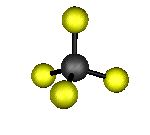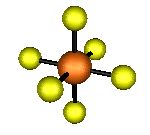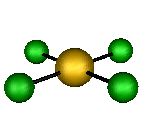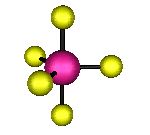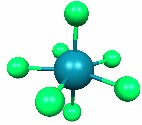Molecular Vibrations
In order to predict equilibrium stable-isotope fractionations, it is necessary
to know the characteristic frequencies of molecular vibrations. It
is also necessary to know how much each vibrational frequency in a molecule
changes when a heavy isotope is substituted for a light one. Vibrational
frequencies for isotopically substituted molecules are not always known,
so it is often necessary to use some type of force-field model to predict
them. Molecular vibrations are also important in understanding infrared
absorption and the mechanisms and kinetics of chemical reactions.
Frequencies are most commonly measured with infrared or Raman spectroscopy.
Rotational-vibrational spectroscopy, isotope substitution, and many forms
of force-field modeling are used to determine characteristic atomic motions.
This page shows some results from quantum-mechanical force-field modeling.
Transition elements like iron are most commonly found in octahedral
and tetrahedral coordination environments. Linear, trigonal-bipyramidal,
square-planar, and cubic coordination also occur. The links below
show typical vibrational motions for molecules with some of these geometries. Most of the animations
show electronically neutral, gas phase molecules with the highest possible
symmetry. The animations should reasonably approximate vibrational motions
of complexes that are less symmetric or otherwise complicated because they
are charged, in solution or part of a weak crystal lattice. Vibrational
motions were calculated by normal-coordinate analysis with the ab initio
electronic structure packages GAMESS and Gaussian03.
Joseph Ochterski has written a good tutorial
explaining in detail how an ab initio software package (in this
case, Gaussian 03) calculates vibrational frequencies and motions.
Quicktime movies of the molecular vibrations were created with MacMolPlt.
The Quicktime movies were converted to animated GIFs using GIFbuilder 1.0
and GraphicConverter 4.0.7. Vibrations in Hg(CH3)2 and ReF7 are animated using the Java applet Jmol. It may be necessary to update your computer's Java installation before viewing the Jmol animations.
Other GIFs of molecular vibrations:
HF
and HCl , from an example calculation predicting stable isotope fractionations
using vibrational spectra.
CO2
H2O
N2O
SO3
NH3
CH4
CHClF2
CCl2F2
CCl3F
CCl2FCClF2
The
symmetric Fe-O stretch of [FeIII(H2O)6]3+ in solution.
This is a stereo image (cross your eyes to see the 3D effect).
